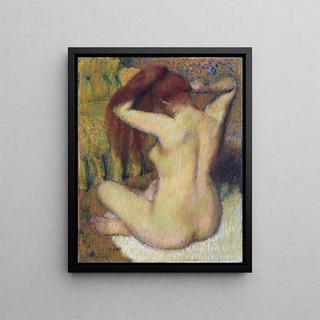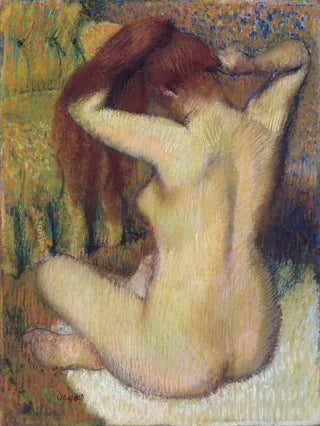Art print | Woman Combing Her Hair - Edgar Degas


View from behind

Frame (optional)
In the captivating world of impressionist art, the art print "Femme se peignant les cheveux" by Edgar Degas stands out for its delicacy and intimacy. This painting, which captures a fleeting moment of daily life, immerses us in a universe where beauty blends with simplicity. The scene depicts a woman, absorbed in a routine gesture, revealing psychological depth and sensitivity that transcend the mere act of combing her hair. The work invites silent contemplation, where the viewer becomes a privileged witness to the intimacy of female life in the 19th century.
Style and uniqueness of the art print
Degas's style is characterized by a constant pursuit of innovation and technical mastery. In "Femme se peignant les cheveux," he employs flowing lines and soft colors to create a soothing atmosphere. The composition, though simple, is rich in nuances and details. Light plays a crucial role, subtly illuminating the woman's face and highlighting the texture of her hair. Degas moves away from academic conventions to offer a more modern vision, where movement and spontaneity are at the heart of the work. This unique approach allows one to feel the emotion and poetry of a fleeting moment, transforming a banal gesture into a timeless art print.
The artist and his influence
Edgar Degas, an emblematic figure of the impressionist movement, left his mark on his era through an innovative approach to painting. Born in 1834 in Paris, he was initially influenced by realism before turning toward impressionism, while maintaining a fascination with the depiction of movement. His work often focuses on daily life, especially that of women, whom he portrays in moments of grace and vulnerability. Degas also experimented with various mediums, including pastel and sculpture, which enabled him to explore diverse themes with unparalleled depth. His influence endures today, inspiring many contemporary artists seeking to capture the essence of life through the lens of modernity and emotion.
A wall decoration of

Matte finish

View from behind

Frame (optional)
In the captivating world of impressionist art, the art print "Femme se peignant les cheveux" by Edgar Degas stands out for its delicacy and intimacy. This painting, which captures a fleeting moment of daily life, immerses us in a universe where beauty blends with simplicity. The scene depicts a woman, absorbed in a routine gesture, revealing psychological depth and sensitivity that transcend the mere act of combing her hair. The work invites silent contemplation, where the viewer becomes a privileged witness to the intimacy of female life in the 19th century.
Style and uniqueness of the art print
Degas's style is characterized by a constant pursuit of innovation and technical mastery. In "Femme se peignant les cheveux," he employs flowing lines and soft colors to create a soothing atmosphere. The composition, though simple, is rich in nuances and details. Light plays a crucial role, subtly illuminating the woman's face and highlighting the texture of her hair. Degas moves away from academic conventions to offer a more modern vision, where movement and spontaneity are at the heart of the work. This unique approach allows one to feel the emotion and poetry of a fleeting moment, transforming a banal gesture into a timeless art print.
The artist and his influence
Edgar Degas, an emblematic figure of the impressionist movement, left his mark on his era through an innovative approach to painting. Born in 1834 in Paris, he was initially influenced by realism before turning toward impressionism, while maintaining a fascination with the depiction of movement. His work often focuses on daily life, especially that of women, whom he portrays in moments of grace and vulnerability. Degas also experimented with various mediums, including pastel and sculpture, which enabled him to explore diverse themes with unparalleled depth. His influence endures today, inspiring many contemporary artists seeking to capture the essence of life through the lens of modernity and emotion.
A wall decoration of






